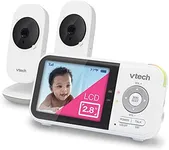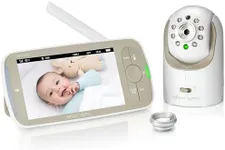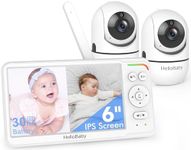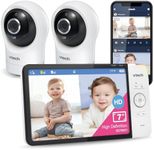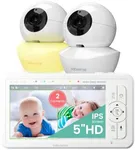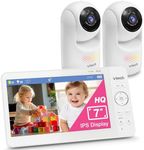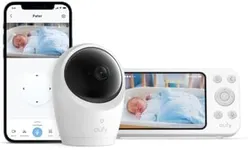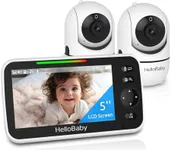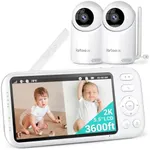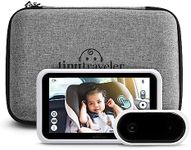Buying Guide for the Best Baby Monitor With Multiple Camera
Choosing the right baby monitor with multiple cameras can be a daunting task, but with the right approach, you can find the perfect fit for your needs. A baby monitor is an essential tool for keeping an eye on your little one, especially if you have multiple children or a larger home. When selecting a baby monitor, consider the key specifications that will ensure you have a reliable and effective monitoring system. Here are some important specs to consider and how to navigate them to make the best choice for your family.RangeThe range of a baby monitor refers to the maximum distance between the camera and the parent unit (or your smartphone) where the signal remains strong and clear. This is important because it determines how far you can move around your home while still being able to monitor your baby. If you live in a small apartment, a shorter range may suffice, but for larger homes or if you plan to use the monitor outside, a longer range is essential. Typically, ranges can vary from 300 feet to over 1000 feet. Assess the size of your living space and choose a monitor with a range that covers all the areas you need to monitor.
Video QualityVideo quality is crucial for clearly seeing your baby on the monitor. It is determined by the resolution of the camera. Higher resolution cameras provide clearer and more detailed images. Common resolutions include 480p (standard definition), 720p (high definition), and 1080p (full high definition). If you want to see fine details, such as your baby's facial expressions, opt for a higher resolution. However, keep in mind that higher resolution monitors may consume more bandwidth and battery life. Choose a resolution that balances clarity with your specific needs and preferences.
Night VisionNight vision allows you to see your baby clearly in low light or dark conditions, which is essential for nighttime monitoring. This feature uses infrared technology to provide a clear image even when the lights are off. The quality of night vision can vary, with some monitors offering clearer images than others. If you plan to use the monitor primarily at night, look for a model with good night vision capabilities. Check user reviews and product descriptions to gauge the effectiveness of the night vision feature.
Audio QualityAudio quality is important for hearing your baby’s sounds and cries clearly. A monitor with good audio quality will have minimal static and interference. Some monitors offer two-way audio, allowing you to talk to your baby through the monitor. This can be useful for soothing your baby without having to enter the room. When evaluating audio quality, consider the clarity of the sound and the volume control options. If you want to be able to hear every little noise your baby makes, prioritize a monitor with high-quality audio.
Battery LifeBattery life determines how long the parent unit or the camera can operate on a single charge. This is important for ensuring continuous monitoring without frequent recharging. Battery life can vary significantly between models, with some lasting only a few hours and others lasting up to 24 hours or more. If you need a monitor that can last through the night or for extended periods, look for one with a longer battery life. Consider your daily routine and how often you can recharge the monitor when making your choice.
ExpandabilityExpandability refers to the ability to add more cameras to the monitoring system. This is particularly important if you have multiple children or want to monitor different areas of your home. Some baby monitors allow you to connect up to four or more cameras to a single parent unit. When choosing a monitor, consider how many cameras you might need now and in the future. Opt for a system that can grow with your family and provide coverage for all the areas you need to monitor.
ConnectivityConnectivity options determine how the baby monitor communicates with the parent unit or your smartphone. Some monitors use a dedicated frequency, while others connect via Wi-Fi. Wi-Fi monitors offer the advantage of remote viewing through a smartphone app, which can be convenient if you want to check on your baby while you’re away from home. However, Wi-Fi monitors can be susceptible to network issues and may require a strong and stable internet connection. Consider your lifestyle and whether remote access is important to you when choosing the connectivity option.
Additional FeaturesAdditional features can enhance the functionality of your baby monitor. These may include temperature sensors, lullabies, motion detection, and pan/tilt/zoom capabilities. Temperature sensors can alert you if the room gets too hot or cold, while lullabies can help soothe your baby to sleep. Motion detection can notify you of any movement in the crib, and pan/tilt/zoom allows you to adjust the camera angle remotely. Think about which features are most important to you and how they can improve your monitoring experience. Choose a monitor that offers the features that best meet your needs.
